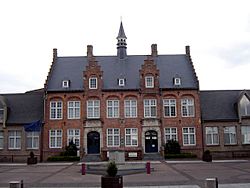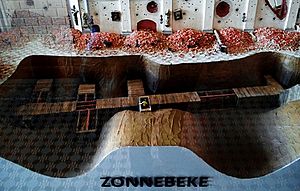Zonnebeke facts for kids
Quick facts for kids
Zonnebeke
|
|||
|---|---|---|---|

Zonnebeke town hall
|
|||
|
|||
| Country | Belgium | ||
| Community | Flemish Community | ||
| Region | Flemish Region | ||
| Province | West Flanders | ||
| Arrondissement | Ypres | ||
| Area | |||
| • Total | 67.57 km2 (26.09 sq mi) | ||
| Population
(2018-01-01)Lua error in Module:Wd at line 1575: attempt to index field 'wikibase' (a nil value).
|
|||
| • Total | Lua error in Module:Wd at line 1,575: attempt to index field 'wikibase' (a nil value). | ||
| Postal codes |
8980
|
||
| Area codes | 051/057 | ||
| Website | www.zonnebeke.be | ||
Zonnebeke is a town in Belgium. It's located in the West Flanders province. The name Zonnebeke comes from "sun" (zonne) and "brook" (beke). This area includes the villages of Beselare, Gheluvelt, Passendale, Zandvoorde, and Zonnebeke itself. In 2006, about 11,758 people lived in Zonnebeke. The total area is 67.57 square kilometers, which means there are about 174 people per square kilometer.
Contents
History of Zonnebeke
The villages in Zonnebeke grew up around a large Augustinian abbey. There was also a Benedictine convent nearby. Both were destroyed in 1580 during a time when religious images were being broken. Only the abbey was rebuilt. Later, during the French occupation, the abbey was taken over.
Passendale, one of Zonnebeke's villages, was part of an important battle in 1382 called the Battle of Westrozebeke.
Zonnebeke During World War I
Zonnebeke was right in the middle of the Ypres Salient during World War I. This means the entire area was completely destroyed. People left the area and it stayed empty until the early 1920s. Slowly, people came back and rebuilt their villages. In 1932, locals started a cheese factory. This factory still makes the famous Passendale cheese today.
Zonnebeke After World War II
Another battle happened in Zonnebeke during World War II. Passendale was used by the Nazis for defense. However, this battle did not cause much damage to the area.
Today, Zonnebeke has a good balance of agriculture (farming), small businesses, and jobs in nearby towns. A major industry here is the brickworks factory in Zonnebeke village. This factory digs up local blue clay to make bricks.
Zonnebeke's Underground Secrets
The Zonnebeke area has many underground structures from World War I. This is because it was a central location during the Third Battle of Ypres, also known as the Battle of Passchendaele. The blue clay that the brickworks factory digs up often reveals these hidden structures.
About 180 underground shelters, called "dugouts," have been found in the Ypres Salient. In the 1990s, some of these dugouts were explored.
Discovering Hidden Dugouts
In 1983, a dugout built by Australians, called the Bremen Redoubt, was found behind the Zonnebeke brickworks. It was open to visitors until 1998. It is thought to have collapsed because its wooden supports dried out.
During archaeological digs at the old Augustinian abbey, another dugout was found under the Zonnebeke church. Today, you can see where this dugout was marked in a special garden at the church. A model of the church dugout is also on display at the "Memorial Museum Passchendaele 1917" in Zonnebeke.
In 1998, a farmer's wife accidentally fell into the ground. This led to the discovery of the Beecham dugout. It was found less than 400 meters from Tyne Cot Cemetery.
In 2006, the brickworks factory got permission to dig for more blue clay. This made people worried about other hidden dugouts. Experts used maps showing 350 underground structures. They found that at least one, the Vampire dugout, was near the new digging area. After talking with local groups, a scientific research project was started to study these important historical sites.
Villages of Zonnebeke
The municipality of Zonnebeke includes several villages. These villages are Zonnebeke itself, Beselare, Gheluvelt, Passendale, and Zandvoorde. Each of these was an independent town before they all joined together in the 1970s.
| # | Name | Area (km2) |
Population (01/01/2014) |
|---|---|---|---|
| I | Zonnebeke | 16,55 | 4.472 |
| II | Beselare | 14,33 | 2.684 |
| III | Gheluvelt | 7,79 | 1.553 |
| IV | Passendale | 22,22 | 3.152 |
| V | Zandvoorde | 6,68 | 521 |
|
Zonnebeke shares borders with several other towns and municipalities:
|
Gallery
-
Zonnebeke (1918), a painting by William Orpen, showing the destruction after World War I
See also
 In Spanish: Zonnebeke para niños
In Spanish: Zonnebeke para niños











